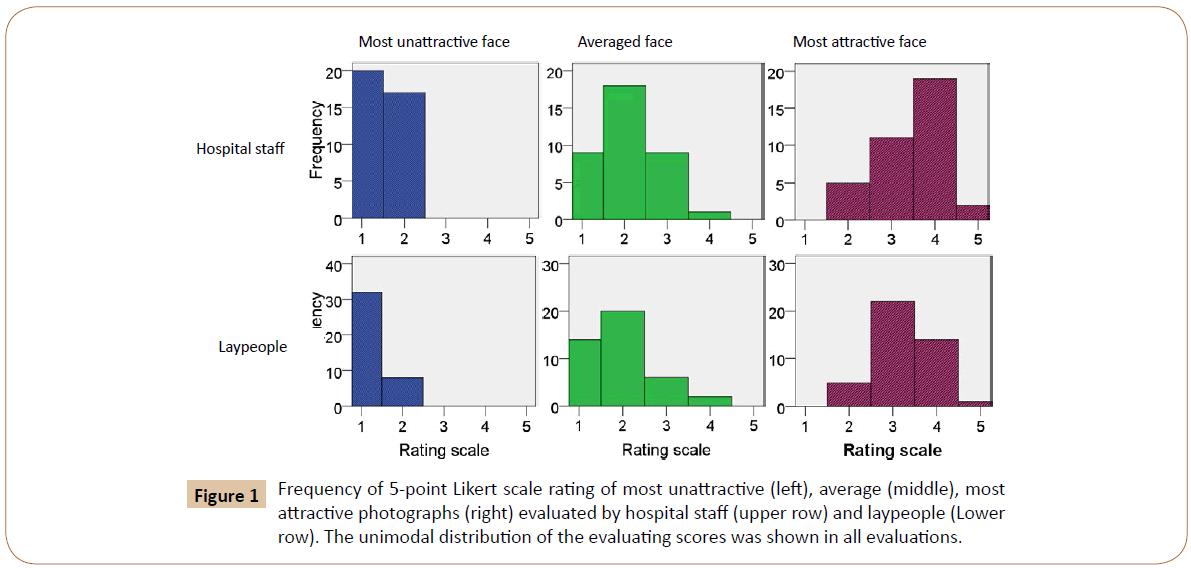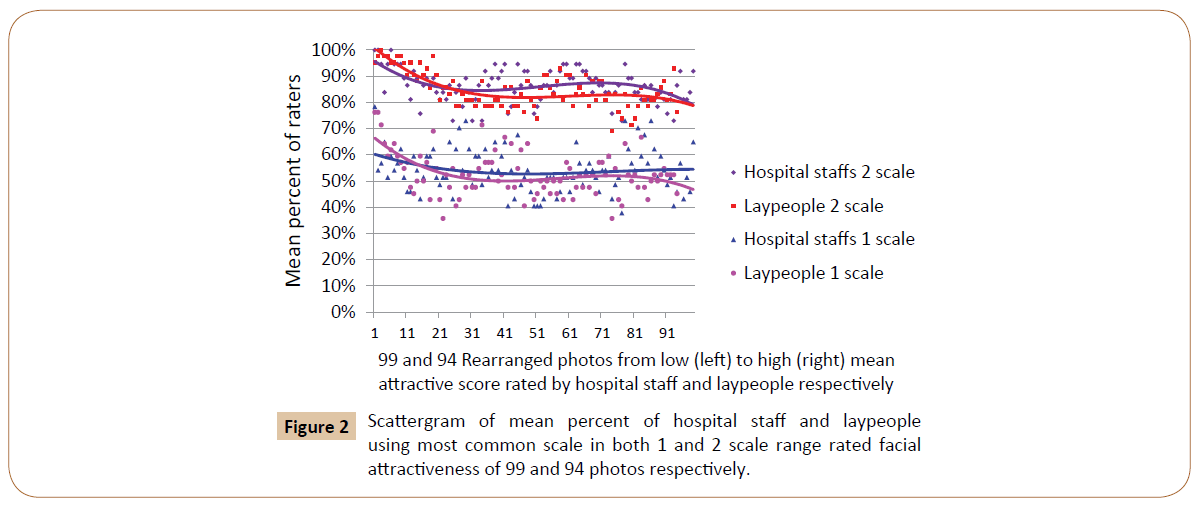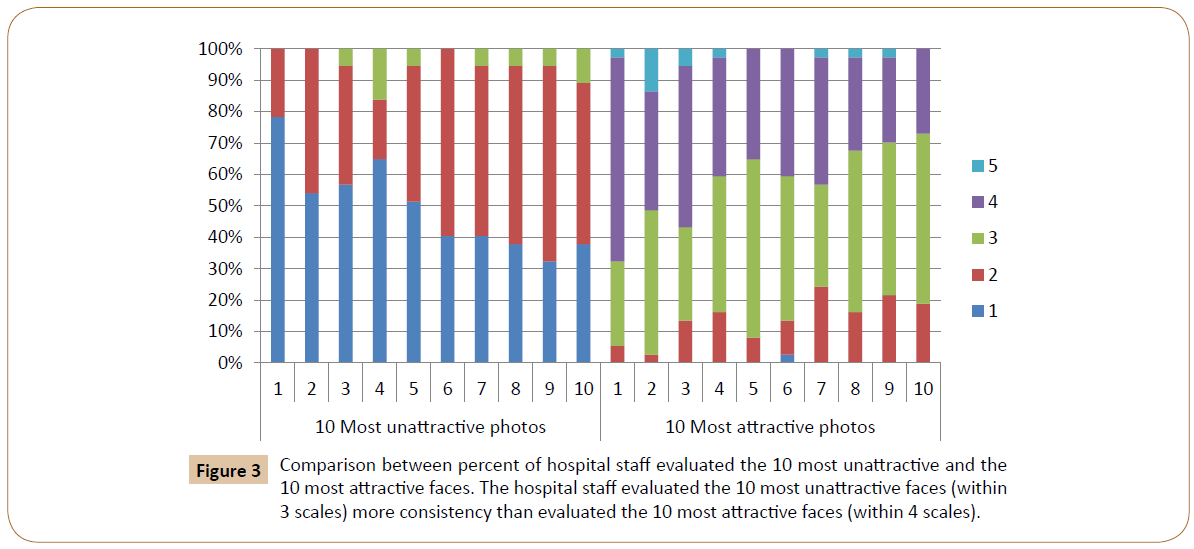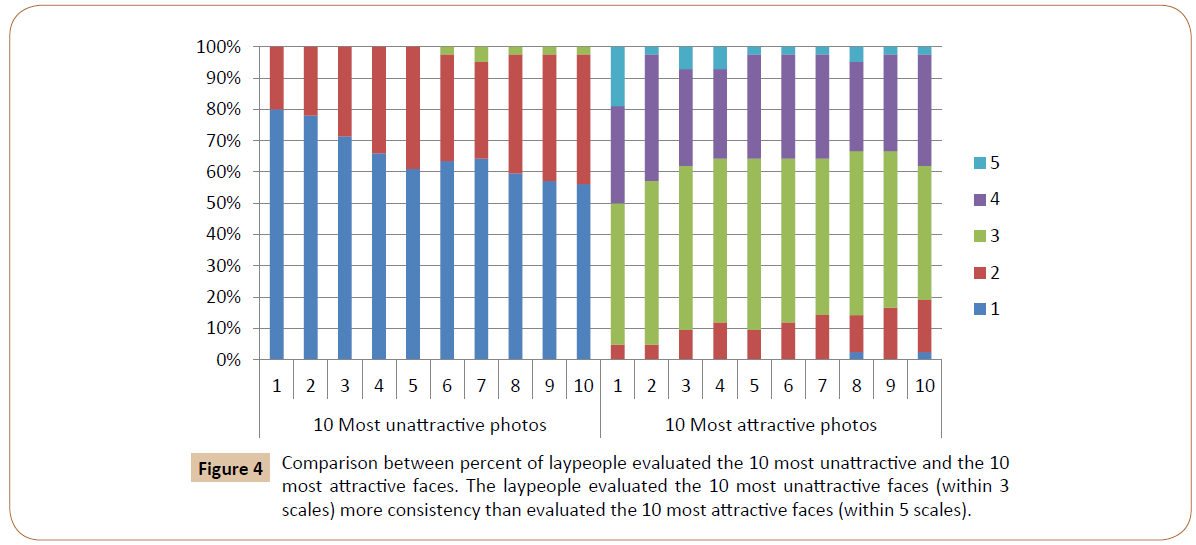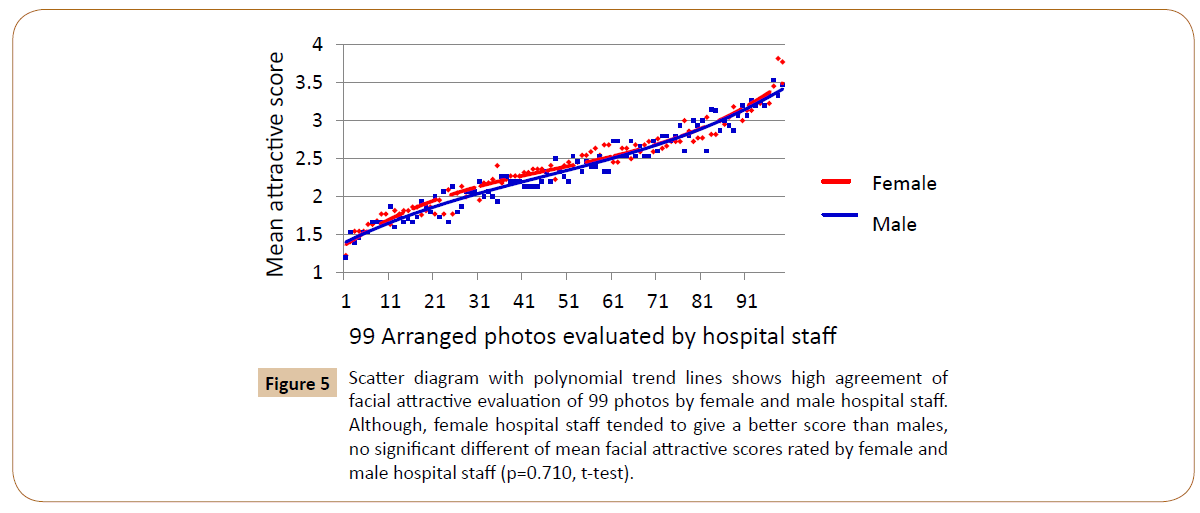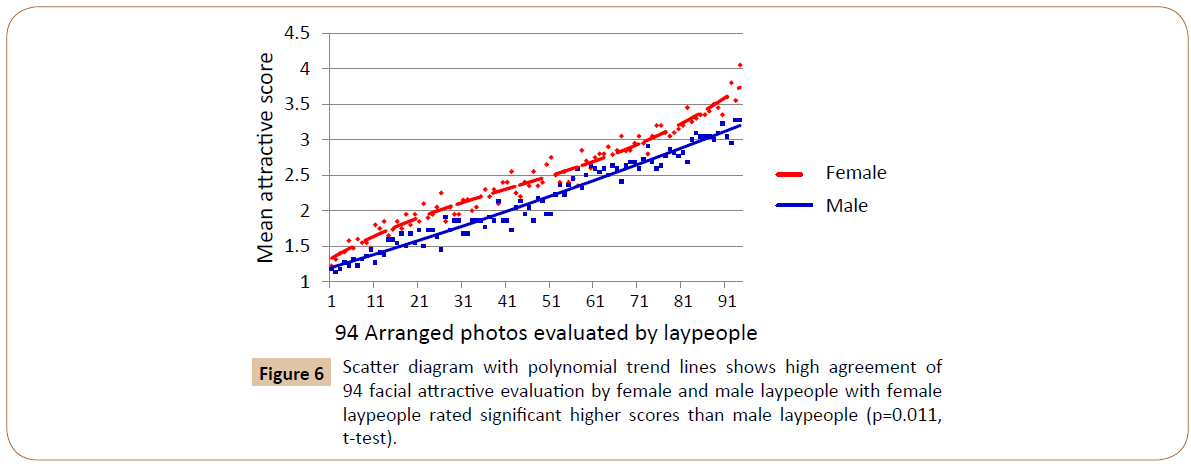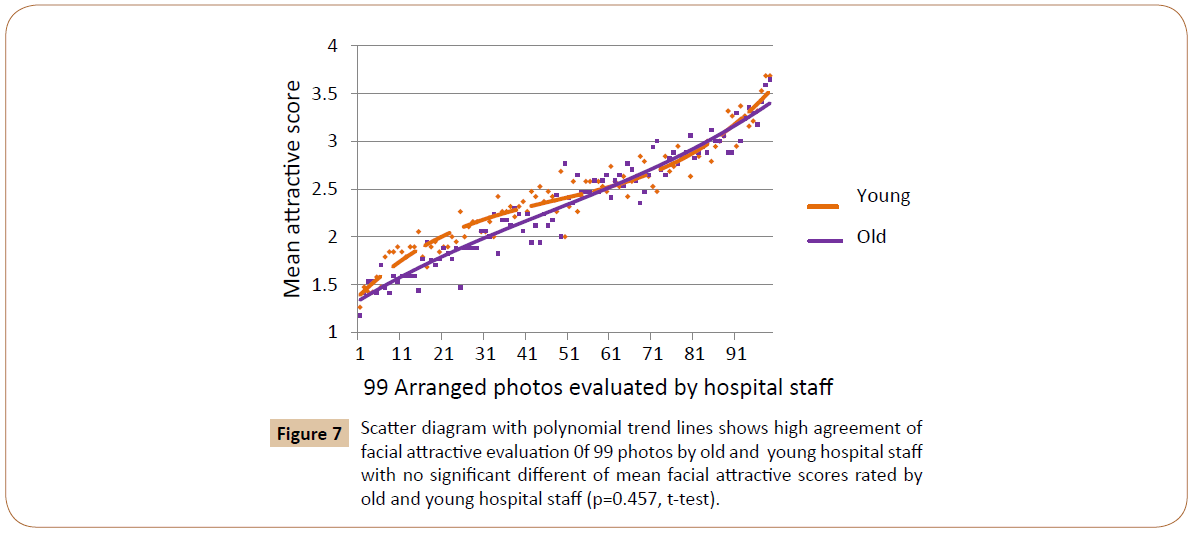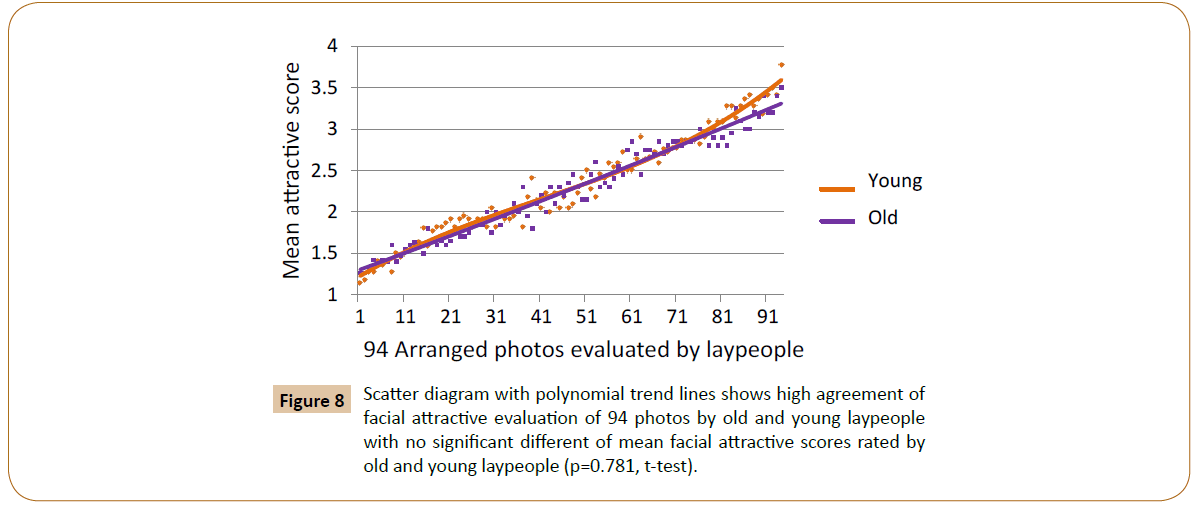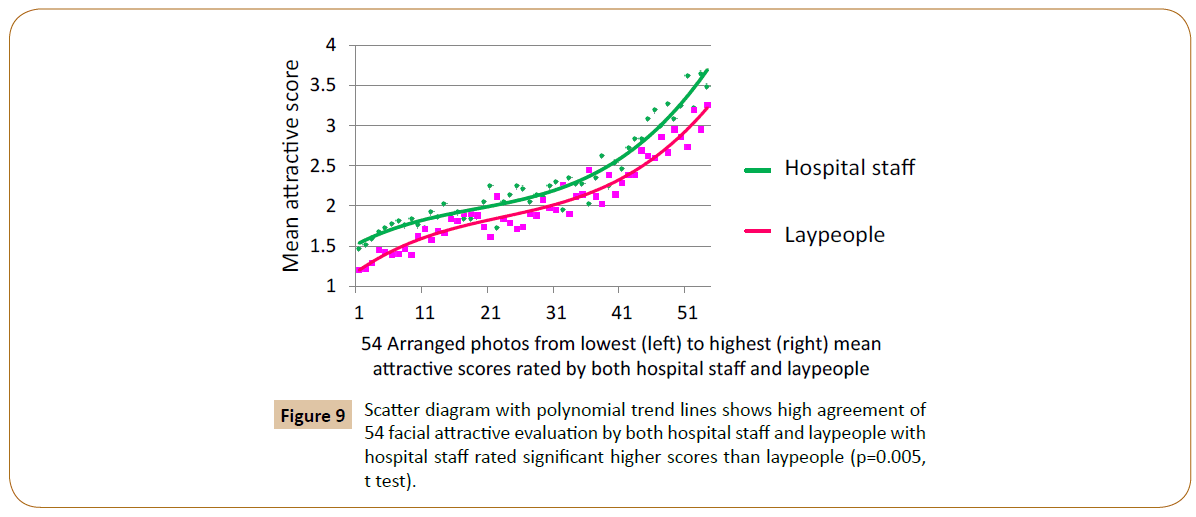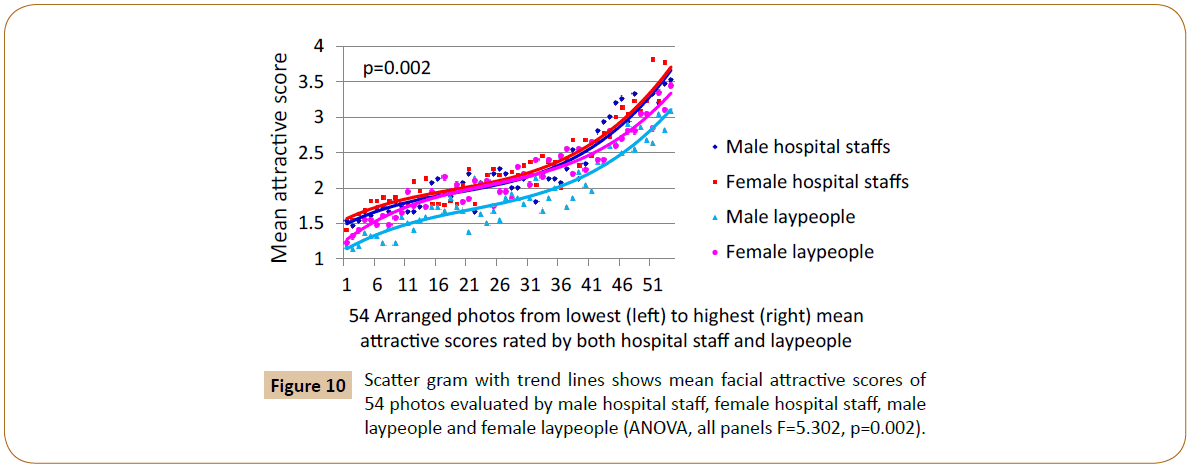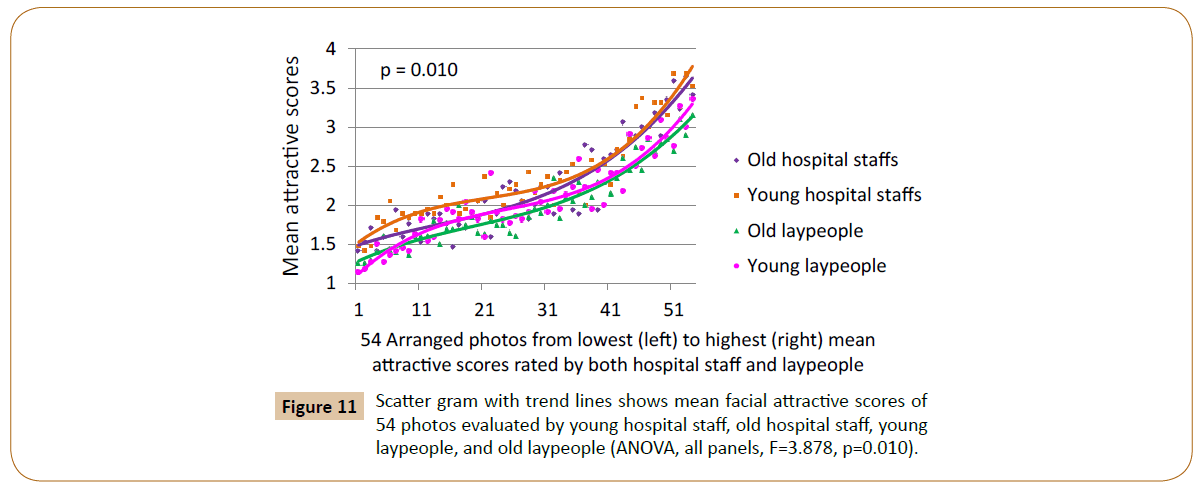Female Facial Attractiveness Assessed by 2D Photography
Jinwara Jirathamopas, Ellen Wen-Ching Ko, Yu Fang Liao, Yu-Ray Chen and Chiung Shing Huang
DOI10.21767/2469-2980.100053
Jinwara Jirathamopas1, Ellen Wen-Ching Ko1,2, Yu Fang Liao1,2, Yu-Ray Chen1,3 and Chiung Shing Huang1,2*
1Graduate Institute of Craniofacial and Dental Science, College of Medicine, Chang Gung University, Taoyuan, Taiwan
2Department of Craniofacial Orthodontics, Craniofacial Research Center, Chang Gung Memorial Hospital, Taipei, Taiwan
3Department of Plastic and Reconstructive Surgery, Craniofacial Research Center, Chang Gung Memorial Hospital, Linkou, Taiwan
- *Corresponding Author:
- Huang CS
Department of Craniofacial Orthodontics
Craniofacial Research Center, Chang Gung Memorial Hospital
Taipei, Taiwan
Tel: +886-3-2118800
E-mail: sshuang@ms1.hinet.net
Received Date: April 10, 2018; Accepted Date: April 20, 2018; Published Date: April 26, 2018
Citation: Jirathamopas J, Ko EW, Liao YF, Chen Y, Huang CS (2018) Female Facial Attractiveness Assessed by 2D Photography. J Orthod Endod 4:4. doi: 10.21767/2469-2980.100053
Abstract
Background: Esthetic concern is always first priority when patient considering an orthodontic treatment. The aim of this study was to evaluate whether the perception of female facial attractiveness is consistency across gender, age and professional background.
Materials and methods: A series of 100 sets female 2D photos were projected on a screen. Each set was consisted one frontal and two laterals right and left views and was shown for 5 seconds. Raters should mark their impression of facial attractiveness on a 5-point Likert scale within the next 3 seconds. Raters included hospital staff and laypeople. The consistency of facial attractive perception was compared between raters according to gender, age and professional background.
Results: High internal consistency of rating female facial attractiveness was achieved by evaluator, no matter of gender, age, or professional background. Every evaluation show central tendency and unimodal distribution regardless of the attractiveness or rater’s background. More consistency is found for the evaluation of unattractive faces than attractive faces by both hospital staff and laypeople. In the evaluation of 2D photos, females give higher score than males and the significant different was found among laypeople (p=0.011). No significant different between the rating of senior and junior raters (p=0.457 and 0.781 for hospital staff and laypeople). Hospital staff rated significant higher score than laypeople (p=0.005).
Conclusion: The Likert’s rating of 2D female facial attractiveness had central tendency and unimodal distribution regardless of attractiveness or rater’s background. The ratings for unattractive faces were more consistent than that of attractive faces. Laypeople were more critical than hospital staff in the evaluation of female facial attractiveness, especially for male laypeople.
Keywords
Facial attractiveness; Likert scale; 2D photography
Introduction
Esthetic concern is always first priority when patient considering an orthodontic treatment. Even in primary and secondary school children, 85% of them recognized the importance of well-aligned teeth for overall facial appearance [1-5]. An understanding of facial attractive perception is essential for orthodontists to address patients' needs for better esthetic improvement. To evaluate the facial beauty, many characteristics including facial proportions and several cephalometric normal values have been proposed from anthropometric or cephalometric measurements. The neoclassical facial-proportion canons, formulated by the Renaissance scholars and artists Dürer, Alberti, Cousin, Audran, Francesca, Pacioli, Cennini, Savonarla and da Vinci, would be one of interest when concerning about facial attractive analysis [6- 8]. The validity of neoclassical canons of facial proportion has been tested among North American Caucasians [6,9,10], Chinese [10-12], African Americans [13-15], Vietnamese [10], Thais [10], Turkish [16], Greece [17] and Korean [18]. They found only 16.7% of vertical facial proportion and 51.5% of horizontal facial proportion fitted to the tested neoclassical canons respectively. This indicated that neoclassical canons were not generally applicable to the human faces.
Golden ratios are commonly implied for facial attractiveness after Ricketts [19] found 6 vertical and 5 horizontal facial proportions equaling to golden ratio [20-22]. Moss et al. showed none of the facial proportions measured from attractive models matched the golden mean [23] and Kiekens et al. found only 4 out of 19 measured facial proportions to be negative correlated to golden ratio with r less than -0.36 [24]. Even Kawakami who supported the used of golden ratio as a guide for maxillofacial surgery of Caucasians, found all of the 7 measured vertical facial proportions deviated from golden proportion in Japanese subjects [25]. Another study in Japanese population, Mizumoto et al. found while the models generally had more balanced faces, their facial measurements showed more deviated from the golden proportion compared with averaged young women [26]. Moreover, case-controlled studies did not advocate the use of golden ratio as facial attractive indicator [24,27-29].
For cephalometric measurements such as Ricketts’ E-plane, there was ethnic diversity and conflicting results. For example, while the distance of lower lips to E plane were, on average, no significant difference in the attractive profile (2.96 ± 1.89 mm) when compare with normal profile (2.73 ± 1.82 mm) in the female Italian samples [30] nor attractive female Turkish profile (-1.00 ± 2.17 mm) in comparison with unattractive samples (-3.55 ± 3.67 mm) [31], this distance is significantly larger in attractive Japanese profile (1.09 ± 1.59 mm) than in normal profile (-0.13 ± 2.51 mm) [32]. And while Oh et al. showed lower lip to E plane were negative correlated to the esthetic rating in 45 American samples (-2.9 ± 3.2 mm), the correlation was not strong (r=-0.29) and there was no statistically correlated in 48 Chinese samples (0.9 ± 2.4 mm). Therefore, using Rickett’s E plane to define the attractive position of lips must be careful. As shown, most of the facial characteristics derived from anthropometric and cephalometric facial measurements cannot provide accurate indicators for facial esthetics; other method should be used when considering the facial attractive evaluation.
Langlois and Roggman rediscovered Galton’s finding in 1878 by creating the averaged composites of male and female faces with computerized method [33]. They proved that averaged composites were generally gained higher attractiveness rating score than their original individual faces. Later other researchers proved that people perceived averaged faces as attractive faces by many other different ways such as facial measurements, facial manipulation by moving the landmark points toward averaged faces, morphing the created averaged facial shape, morphing the faces through inter-pupillary distance and quantitative facial analysis [34-41]. This indicated that facial attractiveness could be sufficiently ensured by facial averageness [7,42].
Many evidences proved that some standard of beauty was set by nature [43] included infants preferring to look at faces that adults find attractive [44-47], people from different cultural background showed high agreement on which faces are attractive and which are not [38,48,49] and experimental studies proved that the time to perceived the facial attractiveness could be as short as 100 ms [50,51].
Up to present, most of anthropometric or cephalometric studies using neoclassical canons, golden ratio, or esthetic lines have been tried hard to define facial attractiveness in two dimensions (2D) but in vain. The perception of facial attractiveness should be in three-dimensional (3D). Therefore a serial 3D analysis on facial attractiveness has been carried out in the Craniofacial Center, Chang Gung Hospital, Taipei, Taiwan. However, in order to classify the 3D facial attractiveness, the validity and reliability of 2D perception of facial attractiveness should be set up first using the conventional evaluation method. This is the first part of these series to evaluate the consistency of 2D perception in female facial attractiveness according to professional background, gender, age.
Material and Methods
Obtained two dimensional photos and three dimensional images
Sets of 2D facial photos (one frontal, one right and one left lateral views) and 3D facial images in rest position were collected from female subjects at Chang Gung Memorial Hospital, Taipei, Taiwan, from 2009-2010. The 2D facial photos were taken with Nikon D300 camera (Nikon Corporation, Tokyo, Japan) with single 105 mm macro lens with an aperture of F14 speed 1/125 second from a standard distance of 1.5 meters. The background was in light blue color. Two umbrella flashes were synchronized with camera flash to reduce the background shadow. The subjects were in standing position with eyes looking forward and face in relaxed and rest position. The 3D full facial images were taken by the 3dMD cranial system (3dMD Inc., Atlanta, GA, USA) in sitting position with eyes looking forward and face in relax and rest position. The capture speed was 1.5 milliseconds per surface image.
The inclusion criteria of the samples were female, age between 20-30 year old, Chinese background, no craniofacial anomalies and no history of facial trauma. This study was concentrated on 2D facial photos. Raters were divided into groups of hospital staff and laypeople. Hospital staff was plastic surgeons, orthodontists and research assistants who work in craniofacial center, Chang Gung Memorial hospital, Taipei, Taiwan. Laypeople were non-medical students and the staff from Chang Gung University, Taoyuan, Taiwan.
During each viewing session, raters were sitting in a classroom with a big screen at front. No other specific instruction was given except to evaluate the facial esthetics. Each set of female color photos (one frontal, one right and one left lateral views), were projected on a screen by PowerPoint for 5 seconds. Total 100 sets of 2D facial photos were randomly arranged without any order of attractiveness. In the next 3 seconds, the photos disappeared from the screen and the raters marked their impression of facial attractiveness on a 5-point Likert scale varied from the most unattractive as 1 to the most attractive as 5. All raters had to turn off their cell phone and computer while rating so that the whole session took 13 minutes 20 seconds to complete without any interruption. Different 100 sets of photos were separately evaluated by hospital staff and laypeople. However, 54 photos were evaluated by both hospital staff and laypeople. To evaluate the intra-rater reliability, 1 set and 6 sets of photographs were duplicated in evaluation by hospital staff and laypeople respectively and raters were not told that there were duplicate images during the evaluation.
Statistics
Outliers: The outliers were removed before data analysis was performed. The criteria of the outliers were:
1. The raters using 1 or 2 scale interval throughout the whole evaluation will be entirely deleted.
2. Any score which was very different from the overall mean scores more than mean ± 3SD would be deleted.
From the first criteria, the 6 hospital staff and 6 laypeople were entirely deleted from 43 hospital staff and 48 laypeople respectively. And from the second criteria, 6 scores and 12 scores were deleted from total 370 and 420 scores evaluated by hospital staff and laypeople respectively.
Consistency and reliability: After removing duplicated photos, there were 99 and 94 photos evaluated by hospital staff and laypeople respectively. The internal consistency and inter-rater reliability were calculated from the evaluation of these photos. To assess the internal consistency of the composed scores within each panel, Cronbach's Alpha coefficient was separately calculated from 99 and 94 photos evaluated by hospital staff and laypeople. To assess the inter-rater reliability, Intra-class Correlation Coefficient (ICC) was calculated from 99 and 94 photos evaluated by hospital staff and laypeople. To assess the intra-rater reliability, paired t test was used to compare the mean attractive scores of first and second time rating of 1 and 6 duplicated photos evaluated by hospital staff and laypeople respectively. Pearson’s correlation coefficient was used to test the correlation between first and second time rating of those duplicated photos.
Agreement of facial attractive perception: The overall facial attractive modes, means and standard deviations for each set of photographs were calculated. The photos were ranged from the most unattractive face to the most attractive face according to their overall mean attractive scores.
To illustrate the distribution pattern of 99 and 94 rating scores evaluated by hospital staff and laypeople respectively, mean percent of raters were calculated from number of raters rating most common used scale for both one and two scale range. To determine the different between perception of attractive and unattractive faces, the 30 lowest mean attractive scored and 30 highest mean attractive scored photos were used as samples representing unattractive and attractive faces respectively. To evaluate whether raters agree more in judging attractive faces attractive or judging unattractive faces unattractive, an independent T test was used to compare the mean percent of raters rating one scale range and two scale range.
Influence of gender, age and professional background on facial attractive evaluation: After ranging the photos from the most unattractive face to the most attractive face according to their overall mean attractive scores, scatter diagrams of mean facial attractive scores given by subdivided groups of raters according to gender, age and professional background were created. In order to demonstrate the tendency of each evaluation, the polynomial or curvilinear trend line were made from Microsoft Excel 2010, using the following equation to calculate the least squares fit through points: y=b+c1x+c2x2+c3x3 where b and c1, c2, c3 are constants.
To assess the influence of gender and age on facial attractive perception, means and standard deviations of the facial attractive evaluation for set of 99 and 94 photos evaluated by hospital staff and laypeople respectively were calculated according to gender and age of raters. An independent t test was used to compare the facial attractive scores between male and female, old and young raters. In addition because the median age of every rater was equal to 30 years old; therefore, we used 30 years old as a reference point. Raters with 30 years and younger were assigned in the young group and raters who are older than 30 years were assigned in the old group.
To assess the influence of professional background on facial attractive perception, means and SDs of the facial attractive evaluation for set of 54 photos which has been evaluated by both hospital staff and laypeople were calculated. An independent t test was used to compare the facial attractive scores between professional backgrounds.
The hospital staff and laypeople were also subdivided regarding their gender and age. One-way Analysis of Variance (ANOVA) was employed to compare the facial attractive perception between four groups of evaluators regarding their gender and age. Post hoc testing was done with the Tukey HSD method for multiple comparisons.
All statistical analysis was performed with software (Statistical package for Social Sciences, Version 19.0, SPSS Inc., Chicago, Illinois, USA) and the statistical significant was set at p ≤ 0.05 for all analyses.
Results
Raters and mean facial attractive scores
After removed the outliers there were total 37 hospital staff and 42 laypeople included in this study. The distribution of gender and mean age of raters, means and standard deviations of attractive scores given by hospital staff and laypeople were shown in Table 1. The overall mean attractive scores of 99 and 94 photos non-duplicated photos evaluated by hospital staff and laypeople equal to 2.39 ± 0.68 and 2.31 ± 0.61 respectively.
| Hospital staff (n=37) | Laypeople (n=42) | |||||
|---|---|---|---|---|---|---|
| N | Age | Mean attractive score | N | Age | Mean attractive score | |
| Male | 15 | 36.93 ± 12.52 | 2.37 ± 0.40 | 22 | 30.00 ± 9.29 | 2.18 ± 0.37 |
| Female | 22 | 32.50 ± 8.76 | 2.41 ± 0.28 | 20 | 28.40 ± 7.84 | 2.50 ± 0.40 |
| Old | 17 | *42.71 ± 9.43 | 2.35 ± 0.36 | 20 | 36.40 ± 5.32 | 2.31 ± 0.41 |
| Young | 20 | 26.63 ± 2.06 | 2.43 ± 0.30 | 22 | 22.73 ± 4.94 | 2.32 ± 0.43 |
| Total | 37 | 34.22 ± 10.45 | 2.39 ± 0.68 | 42 | 29.24 ± 8.56 | 2.31 ± 0.61 |
Table 1: Distribution of raters’ gender, age, and professional background and mean attractive scores of each evaluation.
Consistency and reliability
From evaluation of 99 and 94 photos by hospital staff and laypeople respectively, Cronbach's Alpha showed excellent internal consistency of facial attractive perception in both hospital staff (α=0.999) and laypeople (α=0.989) The ICC showed the inter-rater reliability of hospital staff and laypeople equal to 0.953 and 0.686 respectively.
Mean and standard deviation of attractive scores and comparison between first and second evaluations of duplicated photos were shown in Table 2. Mean attractive score of all 6 pair duplicated photos given by laypeople were higher for the second duplicated photos than the first duplicated photos. But paired t test showed no significant different of mean facial attractive rating scores for each duplicated photos.
| Evaluator | Photo | Mean ± SD | p Value (paired t) |
Pearson’s correlation coefficient (r) |
|---|---|---|---|---|
| Hospital staffs | #88 | 2.24 ± 0.55 | 0.800 | 0.352 |
| #98 | 2.22 ± 0.58 | |||
| Laypeople | #4 | 2.17 ± 0.76 | 0.472 | 0.356 |
| #42 | 2.26 ± 0.73 | |||
| #10 | 3.29 ± 0.67 | 0.439 | 0.400 | |
| #59 | 3.38 ± 0.76 | |||
| #22 | 1.79 ± 0.81 | 0.073 | 0.620 | |
| #88 | 1.98 ± 0.72 | |||
| #23 | 2.60 ± 0.80 | 0.498 | 0.676 | |
| #65 | 2.67 ± 0.87 | |||
| #27 | 2.02 ± 0.72 | 0.133 | 0.765 | |
| #70 | 2.14 ± 0.75 | |||
| #30 | 1.20 ± 0.41 | 0.058 | 0.587 | |
| #79 | 1.34 ± 0.48 |
Table 2: Mean and standard deviation of mean attractive scores of duplicated photos, statistics of differences (p value) and correlation (r) between attractive scores of hospital staffs and laypeople.
Pearson’s correlation coefficients for the association between first and second evaluation of duplicated photos evaluated by hospital staff equal to 0.352 and range from 0.356 to 0.765 for those duplicated photos evaluated by laypeople (Table 2). Every tested correlation were significant (p<0.05).
Agreement of facial attractive perception
Although, 5-point Likert scale was used, every photo was rated with central tendency and unimodal distribution (Figure 1). This distribution was consistently formed for all score distribution no matter of attractiveness of photos or rater’s background. Considering only the most common used of one-scale interval rating each photo, there were mean percent of 54.3 ± 8.4% hospital staff and 52.7 ± 8.3% laypeople. Considering the most common used of 2-scale interval rating each photo, there were mean percent of 86.3 ± 6.4% hospital staff and 84.9 ± 6.8% of laypeople. There was no significant different between the percentage of hospital staff and laypeople rated with the most common scale either with one or two scale interval (p=0.193 and 0.126 respectively) (Table 3) (Figure 2).
| Raters | Scale | Mean percent of raters (range) | ||
|---|---|---|---|---|
| Overall photos | 30 Most unattractive | 30 Most attractive | ||
| Hospital staff | 1 scale | 54.3 ± 8.4% | 56.8 ± 8.4% | 54.8 ± 9.3% |
| 2 scale | 86.3 ± 6.4% | 87.8 ± 6.9% | 83.5 ± 5.2% | |
| Laypeople | 1 scale | 52.7 ± 8.3% | 54.9 ± 10.2% | 51.0 ± 6.5% |
| 2 scale | 84.9 ± 6.8% | 90.4 ± 6.6% | 81.6 ± 5.6% | |
Table 3: Mean percent of raters rating with most common scale.
The difference in rating attractive and unattractive faces by both hospital staff and laypeople was also revealed (Figures 3 and 4). For the most common used of one scale range, 56.8 ± 8.4% and 54.8 ± 9.3% of hospital staff rated 30 most unattractive and 30 most attractive faces respectively and 54.9 ± 10.2% and 51.0 ± 6.5% of laypeople rated 30 most unattractive and 30 most attractive faces respectively. The different between mean percent of raters rating unattractive and attractive with one scale range was no significant (p=0.387 and p=0.083 for hospital staff and laypeople respectively). For the most common used of two scale range, 87.8 ± 6.9% and 83.5 ± 5.2% of hospital staff rated 30 most unattractive and 30 most attractive faces respectively and 90.4 ± 6.6% and 81.6 ± 5.6% of laypeople rated 30 most unattractive and 30 most attractive faces respectively. The different between mean percent of rating unattractive and attractive was significant (p=0.010 and p=0.000 for hospital staff and laypeople respectively). All raters had more consistent in rating unattractiveness than attractiveness.
Comparison of facial attractive perception according to gender
Overall mean attractive score given by male and female raters were shown in Table 1. Mean attractive scores of 99 and 94 photos given by hospital staff and laypeople according to gender were shown in Figures 5 and 6. The differences in overall mean facial attractive scores according to gender were also shown in Table 1. There were no significant difference in the facial attractive evaluation between male and female hospital staff (p=0.710), but female laypeople always gave higher score than male raters. Mean attractive score of female facial attractiveness were significant between male and female laypeople (p=0.011).
Figure 5: Scatter diagram with polynomial trend lines shows high agreement of facial attractive evaluation of 99 photos by female and male hospital staff. Although, female hospital staff tended to give a better score than males, no significant different of mean facial attractive scores rated by female and male hospital staff (p=0.710, t-test).
Comparison of facial attractive perception according to age
Overall mean attractive score given by old and young raters were shown in Table 1. Mean attractive scores of 99 and 94 photos given by hospital staff and laypeople according to age were shown in Figures 7 and 8. There were no significant difference in the facial attractive evaluation between old and young raters in both hospital staff and laypeople (p=0.457 for hospital staff and p=0.781 laypeople).
Comparison of facial attractive perception according to professional background
Figure 9 showed mean facial attractive scores of 54 photographs given by both hospital staff and laypeople. The overall mean attractive score of 54 photographs evaluated by hospital staff and laypeople equal to 2.29 ± 0.34 and 2.04 ± 0.41 respectively. The t test revealed hospital staff gave significant higher scores than laypeople (p=0.005).
Figure 10 showed mean facial attractive scores for gender difference between hospital staff and laypeople (ANOVA, all panels F=5.302, p=0.002). The same trend of facial attractive evaluation was found. In each group female raters gave better score than male raters and hospital staff gave better score than laypeople. Tukey HSD revealed male laypeople gave significantly lower scores than other evaluators. (p=0.010 and p=0.002 for comparison between male laypeople versus male and female hospital staff respectively).
Figure 11 showed mean facial attractive scores for age difference between hospital staff and laypeople (ANOVA, all panels F=3.878, p=0.010). The same trend of facial attractive evaluation was found. In each group young raters gave better score than old raters and hospital staff gave better score than laypeople. Tukey HSD revealed young hospital staff gave significantly higher scores than old laypeople (p=0.012).
Discussion
Raters
In this study, the hospital staff was recruited from people working in the craniofacial center. They represented wide age range and various professional experiences and they were assumed to be representative of people who involved in daily aesthetic assessment and treatment. The laypeople were non-medical university students or teaching staff. None of them was trained in medical, dentistry or the facial art. They were representative of people who appreciated daily for facial esthetics among their own people.
Consistency and reliability
Previous studies allowed time limitation as 10 seconds or 15 seconds or without time limitation [52-64]. However, experimental studies showed that attractiveness could be rapidly and accurately extracted within 1000 ms [50] or 100 ms [51] of viewing time. Therefore, we allowed 5 seconds for evaluators to view the photos and 3 seconds to mark the attractive score on 5-point Likert scale. We found not only the raters made their decision less than 5 seconds, Cronbach's alpha revealed very high internal consistency of female facial attractive perception within groups of hospital staff and laypeople. Moreover, they did not feel any constrain during the evaluation. This study could be the first published evidence to support a person could make the facial attractive judgment within 5 seconds.
The correlation of first and second time attractive evaluation for one week interval was 0.75-0.92 [57] and for two-week interval was 0.23-0.91. However, there was significant difference of ranking score of the duplicated female profile images (p<0.01) [65]. In another study, they showed the Pearson correlation coefficient of the immediate evaluation between first and second time ranged from 0.40-0.87. These showed that although there were difference opinions within individuals, the consensus of the overall evaluators still high enough [55]. In this study, although paired t test showed no significant different among the facial attractive evaluation of all raters, the mean score of second viewing always higher than the first viewing for all 6 duplicated photos evaluated by laypeople. This phenomenon could explain the more you see someone, the more you like them. Moreover, positive correlation of first and second time evaluation for all of duplicated photos were significant different. Although one duplicated photo evaluated by hospital staff (xÃÆà âÃâââ¬Â¦#88=2.24 ± 0.55, xÃÆà âÃâââ¬Â¦#98=2.22 ± 0.59; r=0.0352) and 2 out of 6 duplicated photos evaluated by laypeople (xÃÆà âÃâââ¬Â¦#4=2.17 ± 0.76, xÃÆà âÃâââ¬Â¦#42=2.26 ± 0.73; r=0.356 and xÃÆà âÃâââ¬Â¦#10=3.29 ± 0.67, xÃÆà âÃâââ¬Â¦#59=3.38 ± 0.76; r=0.40) were not high, the correlations of other 4 duplicated photos were moderate to good (r=0.587-0.765).
Agreement of facial attractive perception
The present study also clearly showed that any raters regardless the gender, age or professional background agreed to judge unattractive faces with low mean attractive scores and agreed to judge attractive faces with high mean attractive scores. These evaluations were distributed with central distribution. As shown in Figure 1, although the attractive scales varied from 1 to 5, no matter of unattractive, average or attractive photos the rating scores by hospital staff or laypeople would be concentrated within one to two scales with only single mode distribution. This was well-supported by Figures 4 and 5 that each photo was well-uniformed rated within 2 scale by majority of evaluators (86.3% of hospital staff and 84.9% of laypeople). Similar to other study, which showed a well-formed mode centered around 5 for the mean attractive score of 5.15 ± 1.76 in Likert scale from 1 to 9. This indicated a strong central tendency exists even the raters are from different population [66].
Moreover, the consistency of agreement in judging unattractive faces unattractive was higher than the consistency of agreement in judging attractive faces attractive because evaluators used within 2 to 3 scales to evaluate the 10 most unattractive photos while used 3 or more scales to evaluate the 10 most attractive photos. In other words, people showed more variety of opinions in judging the attractive faces attractive than judged unattractive faces unattractive.
Effect of gender on female facial attractive perception of hospital staff
For the assessing of the effect of gender on facial attractive perception among groups of hospital staff, there was no significant different between male and female raters though female raters tend to give higher score. Similar result was found that dentists and orthodontists showed perfect agreement in their profile evaluation [56]. These might indicated that trained people such as orthodontist and plastic surgeon used similar standard to evaluate the female facial attractiveness. The finding results were different from Kieken et al. who found male orthodontists rated the female adolescents more attractive than the female orthodontists [67]. These might due to different groups of evaluators and different sets of photographs used in their study especially the three-quarter smiling view included. The smiling view might impact on the evaluation [68]. It was also found that female orthodontists detected significant differences of smile arc and buccal corridors width while male orthodontist did not [69].
Effect of gender on female facial attractive perception of laypeople
In laypeople, however, male laypeople rated female faces with significant lower scores than female laypeople did. While the female attractive perception among female and male laypeople most of the male laypeople were still single at the time of rating. This suggested that male laypeople were more critical in female attractive evaluation than female laypeople. Similar result was found in other study that male raters rated attractiveness of the female patients who presenting at dermatology lower scores than female raters [70]. In contrast, other found male laypeople tend to give higher scores than female laypeople. These findings supported an idea that different standard might existed for facial attractiveness between male and female evaluators as male and female raters might perceive female facial attractiveness differently [71]. For the female profile preferences, it was found that male evaluators more preferred to the convex profiles while female evaluators more preferred to the concave profiles [56] or while both male and female evaluators are in agree in preference of lip position that is more protrusive than Rickett’s standard, female prefer a fuller lip position than males in both female and male stimulus faces [72]. However, some other studies found there was no significant different between the female attractiveness evaluation by male and female laypeople [38,62,65,67].
Effect of age on female facial attractive perception of hospital staff and laypeople
For an effect of age, we found both young hospital staff and laypeople evaluated the female facial attractiveness similarly with old hospital staff and laypeople respectively. Kiekens RMA et al set the effect for age by using dichotomized at 46 years of age and also found the same result that “age effect” was not found in the female attractive perception of orthodontists and laypeople [67].
Effect of professional background between hospital staff and laypeople on female facial attractive perception
Although many studies agreed that dental professions especially orthodontists are more critical and more sensitive in judging the esthetic of teeth and smile [73-76], the controversy whether the professional are more or less critical than the laypeople when judging the beauty of the face existed. While some studies revealed that professionals were less critical [52,53,59,65], others found there were no significant in facial esthetic evaluation between professional and laypeople [55,68] or even found that laypeople were less critical [57,67,77]. This study found while hospital staff and laypeople generally agreed in their perceptions of facial attractiveness, significant different was observed as laypeople are more critical than the hospital staff. It supported an idea that different standard existed for facial attractiveness between professional and laypeople such as orthodontists preferred more forward profile than laypeople do [78] or different attractive rating score will be given to different facial profile between laypeople and orthodontists [56,60,65].
Previous studies proposed many factors yielding differences of facial attractive perception between hospital staff and laypeople. For example socioeconomic and societal factors, lower socioeconomic raters tended to score less favorably than those in higher groups [79]. Another study suggested that the level of dental education or training experience has a significant effect on facial attractive evaluation because they found that orthodontic residents consistently rating patients as more attractive than dental students and laypeople [53]. In addition, it was found that the laypeople took lesser time to complete the attractive evaluation than orthodontists and oral surgeons; therefore, it might be concluded that laypeople tended to rate the profiles on their initial evaluations while orthodontists and oral surgeons might over evaluated each profiles [64]. Also, laypeople might make their evaluations based on the entire face while orthodontists and oral surgeons tend to direct their attention to certain portion of facial profile such as the dentoalveolar region and concentrate on a specific area of the profile. Other study also supported that orthodontists were more focused on and influenced by the profile than on the whole face [59]. This study, however, showed that differences between gender and age of raters were factors caused the different of attractive perception between professional and laypeople. For gender, male laypeople were the most critical group when judging female facial attractiveness. Therefore hospital staff should be aware of their less critical facial attractive perception than the patients especially compare to the male patients.
For age, although there was no significant different within hospital staff and laypeople, but there was significant different between young hospital staff and old laypeople. Young hospital staff was the less critical group and old laypeople were the most critical group when judging female facial attractiveness. Therefore, young hospital staff especially the one who involving craniofacial patients should be aware of the fact that they might have a different perception of facial attractiveness especially with the old laypeople.
Limitations
The hospital staff in our study was staff working in craniofacial center who involved with craniofacial patients. They do not exactly represent the general hospital staff. And laypeople were limited only to university students and staff considering as well-educated young adults. Further studies should expand more to other populations. Based on 2 dimensional photographs, we have proved that the consistency of the female facial attractive evaluation was very high; however, factors of gender and professional background might affect the opinions. With the advancement of 3D technology improvement we should find new ways to be able to assess the attractiveness of the face more accurate. The finding of this study are important to remind that the decision to perform treatment enhance facial beauty should not be based only on professional preference, but also on the patient’s perception of facial esthetics. Moreover, the facial evaluation in this study only focused on female facial attractiveness, further studies should proceed with more focusing on the male facial attractiveness.
Conclusions
1. High internal consistency of female facial attractive perception is achieved by evaluators, no matter of gender, age, or professional background.
2. Inter-rater reliability is high for hospital staff, but moderate for laypeople.
3. Laypeople tend to give higher score for the second time viewing of all 6 duplicated photos.
4. Every evaluation show central tendency and unimodal distribution regardless of the attractiveness or rater’s background.
5. More consistency is found for the evaluation of unattractive faces than attractive faces by both hospital staff and laypeople.
6. In hospital staff, factors of gender and age would not influence the female facial attractiveness evaluation.
7. In laypeople, male evaluators were more critical than female evaluators in the evaluation of female facial attractiveness.
8. In laypeople, the factors of age would not influence the evaluation of female facial attractiveness.
9. Laypeople were more critical than hospital staff in the evaluation of female facial attractiveness.
10. While other raters gave similar trend for female facial attractiveness, male laypeople was the most critical.
Funding
This project was supported by Chang Gung Memorial Hospital (CRRPG5C0263, CRRPG5C0223) and Ministry of Science and Technology, Taiwan (103-2314-B-182-042-MY2).
References
- Birkeland K, Boe OE, Wisth PJ (1996) Orthodontic concern among 11-year-old children and their parents compared with orthodontic treatment need assessed by index of orthodontic treatment need. Am J Orthod Dentofac Orthop 110: 197-205.
- Mugonzibwa EA, Kuijpers-Jagtman AM, Van’t Hof MA, Kikwilu EN (2004) Perceptions of dental attractiveness and orthodontic treatment need among Tanzanian children. Am J Orthod Dentofac Orthop 125: 426-433.
- Onyeaso CO (2003) An assessment of relationship between self-esteem, orthodontic concern and Dental Aesthetic Index (DAI) scores among secondary school students in Ibadan, Nigeria. International Dental Journal 53: 79-84.
- Mandall NA, McCord JF, Blinkhorn AS, Worthington HV, O'Brien KD (2000) Perceived aesthetic impact of malocclusion and oral self-perceptions in 14-15-year-old Asian and Caucasian children in greater Manchester. Eur J Orthod 22: 175-183.
- Pabari S, Moles DR, Cunningham SJ (2011) Assessment of motivation and psychological characteristics of adult orthodontic patients. Am J Orthod Dentofac Orthop 140: e263-e72.
- Farkas LG, Hreczko TA, Kolar JC, Munro IR (1985) Vertical and horizontal proportions of the face in young adult North American Caucasians: Revision of neoclassical canons. Plast Reconstr Surg 75: 328-338.
- Bashour M (2006) History and current concepts in the analysis of facial attractiveness. Plast Reconstr Surg 118: 741-756.
- Naini FB, Gill DS (2008) Facial Aesthetics: 1. Concepts and Canons. Dental Update 102-107.
- Farkas LG, Katic MJ, Hreczko TA, Deutsch C, Munro IR (1984) Anthropometric proportions in the upper lip-lower lip-chin area of the lower face in young white adults. Am J Orthod 86: 52-60.
- Le TT, Farkas LG, Ngim RC, Levin LS, Forrest CR (2002) Proportionality in Asian and North American Caucasian faces using neoclassical facial canons as criteria. Aesthet Plast Surg 26: 64-69.
- Jayaratne YS, Deutsch CK, McGrath CP, Zwahlen RA (2012) Are neoclassical canons valid for Southern Chinese faces? PloS ONE 7: e52593.
- Wang D, Qian G, Zhang M, Farkas LG (1997) Differences in horizontal, neoclassical facial canons in Chinese (Han) and North American Caucasian populations. Aesthet Plast Surg 21: 265-269.
- Farkas LG, Forrest CR, Litsas L (2000) Revision of neoclassical facial canons in young adult Afro-Americans. Aesthet Plast Surg 24: 179-184.
- Porter JP (2004) The average African American male face: an anthropometric analysis. Arch Facial Plast Surg 6: 78-81.
- Porter JP, Olson KL (2001) Anthropometric facial analysis of the African American woman. Arch Facial Plast Surg 3: 191-197.
- Bozkir MG, Karakas P, Oguz O (2004) Vertical and horizontal neoclassical facial canons in Turkish young adults. Surgical and Radiologic Anatomy 26: 212-219.
- Zacharopoulos GV, Manios A, De Bree E, Kau CH, Petousis M, et al. (2012) Neoclassical facial canons in young adults. J Craniofac Surg 23: 1693-1698.
- Choe KS, Sclafani AP, Litner JA, Yu GP, Romo T 3rd (2004) The Korean American woman's face: Anthropometric measurements and quantitative analysis of facial aesthetics. Arch Facial Plast Surg 6: 244-252.
- Ricketts RM (1982) The biologic significance of the divine proportion and Fibonacci series. Am J Orthod 81: 351-370.
- Jefferson Y (1996) Skeletal types: Key to unraveling the mystery of facial beauty and its biologic significance. J Gen Orthod 7: 7-25.
- Jefferson Y (2004) Facial beauty: Establishing a universal standard. Int J Orthod Milwaukee 15: 9-22.
- Edler RJ (2001) Background considerations to facial aesthetics. J Orthod 28: 159-168.
- Moss JP, Linney AD, Lowey MN (1995) The use of three-dimensional techniquesin facial esthetics. Semin Orthod 1: 94-104.
- Kiekens RM, Kuijpers-Jagtman AM, van 't Hof MA, van 't Hof BE, Maltha JC (2008) Putative golden proportions as predictors of facial esthetics in adolescents. Am J Orthod Dentofacial Orthop 134: 480-483.
- Kawakami S, Tsukada S, Hayashi H, Takada Y, Koubayashi S (1989) Golden proportion for maxillofacial surgery in Orientals. Ann Plast Surg 23: 417-425.
- Mizumoto Y, Deguchi T, Sr Fong KW (2009) Assessment of facial golden proportions among young Japanese women. Am J Orthod Dentofacial Orthop 136: 168-174.
- Rossetti A, De Menezes M, Rosati R, Ferrario VF, Sforza C (2013) The role of the golden proportion in the evaluation of facial esthetics. Angle Orthod 83: 801-808.
- Scolozzi P, Momjian A, Courvoisier D (2011) Dentofacial deformities treated according to a dentoskeletal analysis based on the divine proportion: Are the resulting faces de facto "divinely" proportioned? J Craniofac Surg 22: 147-150.
- Baker BW, Woods MG (2001) The role of the divine proportion in the esthetic improvement of patients undergoing combined orthodontic/orthognathic surgical treatment. Int J Adult Orthodon Orthognath Surg 16: 108-120.
- Sforza C, Laino A, D'Alessio R, Grandi G, Binelli M, et al. (2009) Soft-tissue facial characteristics of attractive Italian women as compared to normal women. Angle Orthod 79: 17-23.
- Erbay EF, Caniklioglu CM (2002) Soft tissue profile in Anatolian Turkish adults: Part II. Comparison of different soft tissue analyses in the evaluation of beauty. Am J Orthod Dentofac Orthop 121: 65-72.
- Alcalde RE, Jinno T, Orsini MG, Sasaki A, Sugiyama RM, et al. (2000) Soft tissue cephalometric norms in Japanese adults. Am J Orthod Dentofac Orthop 118: 84-89.
- Langlois JH, Roggman LA (1990) Attractive faces are only average. Psychol Sci 1: 115-121.
- Grammer K, Thornhill R (1994) Human (Homo sapiens) facial attractiveness and sexual selection: The role of symmetry and averageness. J Comp Psychol 108: 233-242.
- Baudouin JY, Tiberghien G (2004) Symmetry, averageness and feature size in the facial attractiveness of women. Acta psychological 117: 313-332.
- Rhodes G, Yoshikawa S, Clark A, Lee K, McKay R, et al. (2001) Attractiveness of facial averageness and symmetry in non-western cultures: In search of biologically based standards of beauty. Perception 30: 611-625.
- Valenzano DR, Mennucci A, Tartarelli G, Cellerino A (2006) Shape analysis of female facial attractiveness. Vision Res 46: 1282-1291.
- Perrett DI, May KA, Yoshikawa S (1994) Facial shape and judgments of female attractiveness. Nature 368: 239-242.
- Valentine T, Darling S, Donnelly M (2004) Why are average faces attractive? The effect of view and averageness on the attractiveness of female faces. Psychon Bull Rev 11: 482-487.
- Zhang D, Zhao Q, Chen F (2011) Quantitative analysis of human facial beauty using geometric features. Pattern Recognition 44: 940-950.
- Komori M, Kawamura S, Ishihara S (2009) Averageness or symmetry: Which is more important for facial attractiveness? Acta Psychol 131: 136-142.
- Rubenstein AJ, Langlois JH, Roggman LA (2002) What makes a face attractive and why: The role of averageness in defining facial beauty. In: Facial attractiveness: Evolutionary, Cognitive, and Social Perspectives. Advances in Visual Cognition 1. Rhodes G, Zebrowitz L A (eds) Ablex Publishing, United States.
- Rhodes G, Proffitt F, Grady J, Sumich A (1998) Facial symmetry and the perception of beauty. Psychonomic Bulletin and Review 5: 659-669.
- Samuels CA, Ewy R (1985) Aesthetic perception of faces during infancy. Br J Dev Psychol 3: 221-228.
- Langlois JH, Roggman LA, Casey RJ, Ritter JM, Rieser-Danner LA, et al. (1987) Infant preferences for attractive faces: Rudiments of a stereotype. Dev Psychol 23: 363-369.
- Langlois JH, Roggman LA, Rieser-Danner LA (1990) Infants' differential social responses to attractive and unattractive faces. Dev Psychol 26: 153-159.
- Langlois JH, Ritter JM, Roggman LA, Vaughn LS (1991) Facial diversity and infant preferences for attractive faces. Dev Psychol 27: 79-84.
- Jones D, Hill K (1993) Criteria of facial attractiveness in five populations. Hum Nat 4: 271-296.
- Cunningham MR, Roberts AR, Barbee AP, Druen PB, Wu CH (1995) Their ideas of beauty are, on the whole, the same as ours: Consistency and variability in the cross-cultural perception of female physical attractiveness. J Pers Soc Psychol 68: 261-279.
- Olson IR, Marshuetz C (2005) Facial attractiveness is appraised in a glance. Emotion 5: 498-502.
- Locher P, Unger R, Sociedade P, Wahl J (1993) At first glance: Accessibility of the physical attractiveness stereotype. Sex Roles 28: 729-743.
- Chung EH, Borzabadi-Farahani A, Yen SL (2013) Clinicians and laypeople assessment of facial attractiveness in patients with cleft lip and palate treated with LeFort I surgery or late maxillary protraction. Int J Pediatr Otorhinolaryngol 77: 1446-1450.
- Philips C, Tulloch C, Dann C (1992) Rating of facial attractiveness. Community Dent Oral Epidemiol 20: 214-220.
- Kiekens RMA, Maltha JC, van‘t Hof MA, Kuijpers-Jagtman AM (2005) A measuring system for facial aesthetics in Caucasian adolescents: Reproducibility and validity. Eur J Orthod 27: 579-584.
- Peerlings RH, Kuijpers-Jagtman AM, Hoeksma JB (1995) A photographic scale to measure facial aesthetics. Eur J Orthod 17: 101-109.
- Türkkahraman H, Gökalp H (2004) Facial Profile Preferences among Various Layers of Turkish Population. Angle Orthod 74: 640-647.
- Lundstrom A, Woodside DG, Popovich F (1987) Panel assessments of facial profile related to mandibular growth direction. Eur J Orthod 9: 271-278.
- Vargo JK, Gladwin M, Ngan P (2003) Association between ratings of facial attractiveness and patients' motivation for orthognathic surgery. Orthod Craniofac Res 6: 63-71.
- Spyropoulos MN, Halazonetis DJ (2001) Significance of the soft tissue profile on facial esthetics. Am J Orthod Dentofacial Orthop 119: 464-471.
- Chan EK, Soh J, Petocz P, Darendeliler MA (2008) Esthetic evaluation of Asian-Chinese profiles from a white perspective. Am J Orthod Dentofacial Orthop 133: 532-538.
- Varlik SK, Demirbas E, Orhan M (2010) Influence of lower facial height changes on frontal facial attractiveness and perception of treatment need by lay people. Angle Orthod 80: 1159-1164.
- Davidenko N (2007) Silhouetted face profiles: A new methodology for face perception research. J Vis 7:6.
- Tigue CC, Pisanski K, O'Connor JJ, Fraccaro PJ, Feinberg DR (2012) Men's judgments of women's facial attractiveness from two- and three-dimensional images are similar. J Vis 12: 3.
- Maple JR, Vig KW, Beck FM, Larsen PE, Shanker S (2005) A comparison of providers' and consumers' perceptions of facial-profile attractiveness. Am J Orthod Dentofacial Orthop 128: 690-696.
- Abu Arqoub SH, Al-Khateeb SN (2011) Perception of facial profile attractiveness of different antero-posterior and vertical proportions. Eur J Orthod 33: 103-111.
- Gunes H, Piccardi M (2006) Assessing facial beauty through proportion analysis by image processing and supervised learning. Int J Hum Comput Interact 64: 1184-1199.
- Kiekens RM, van’t Hof MA, Straatman H, Kuijpers-Jagtman AM, Maltha JC (2007) Influence of panel composition on aesthetic evaluation of adolescent faces. Eur J Orthod 29: 95-99.
- Havens DC, McNamara Jr JA, Siglerc LM, Baccettid T (2010) The role of the posed smile in overall facial esthetics. Angle Orthod 80: 322-328.
- Parekh SM, Fields HW, Beck M, Rosenstiel S (2006) Attractiveness of variations in the smile arc and buccal corridor space as judged by orthodontists and laymen. Angle Orthod 76: 557-563.
- Nestor MS, Stillman MA, Frisina AC (2010) Subjective and objective facial attractiveness: Ratings and gender differences in objective appraisals of female faces. J Clin Aesthet Dermatol 3: 31-36.
- Schmid K, Marx D (2008) Computation of a face attractiveness index based on neoclassical canons, symmetry, and golden ratios. Pattern Recognition 41: 2710-17.
- Hier LA, Evans CA, BeGole EA, Giddon DB (1999) Comparison of preferences in lip position using computer animated imaging. The Angle Orthodontist 69: 231-38.
- Kokich VO, Kokich VG, Kiyak HA (2006) Perceptions of dental professionals and laypersons to altered dental esthetics: Asymmetric and symmetric situations. Am J Orthod Dentofacial Orthop 130: 141-151.
- Pinho S, Ciriaco C, Faber J, Lenza MA (2007) Impact of dental asymmetries on the perception of smile esthetics. Am J Orthod Dentofacial Orthop 132: 748-753.
- Johnston CD, Burden DJ, Stevenson MR (1999) The influence of dental to facial midline discrepancies on dental attractiveness ratings. Eur J Orthod 21: 517-522.
- Martin AJ, Buschang PH, Boley JC, Taylor RW, McKinney TW (2007) The impact of buccal corridors on smile attractiveness. Eur J Orthod 29: 530-537.
- Kerr WJ, O'Donnell JM (1990) Panel perception of facial attractiveness. Br J Orthod 17: 299-304.
- Orsini MG, Huang GJ, Kiyak HA, Ramsay DS, Bollen AM, et al. (2006) Methods to evaluate profile preferences for the anteroposterior position of the mandible. Am J Orthod Dentofacial Orthop 130: 283-291.
- Howells DJ, Shaw WC (1985) The validity and reliability of ratings of dental and facial attractiveness for epidemiologic use. Am J Orthod 88: 402-428.
Open Access Journals
- Aquaculture & Veterinary Science
- Chemistry & Chemical Sciences
- Clinical Sciences
- Engineering
- General Science
- Genetics & Molecular Biology
- Health Care & Nursing
- Immunology & Microbiology
- Materials Science
- Mathematics & Physics
- Medical Sciences
- Neurology & Psychiatry
- Oncology & Cancer Science
- Pharmaceutical Sciences
